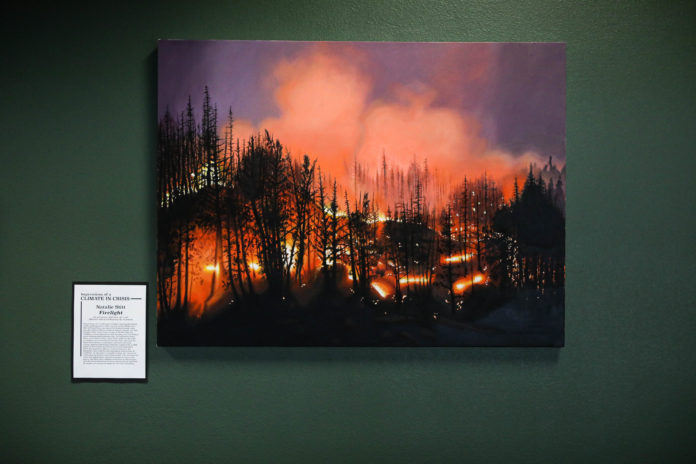
By Avery Ballmann | Staff Writer
Beginning in May, the Crosshatch Corridor, located on the first floor of Moody Memorial and Jones Libraries, began receiving a transformation of new student artwork that had been submitted to the fifth annual Climate Crisis Art Exhibit in the spring.
The Crosshatch Corridor and other library exhibits are overseen by Eric Ames, assistant director for marketing and communications for ITS and libraries.
“We call them that because in art, a crosshatch is laying two lines on top of each other to make something new,” Ames said. “We like the idea of the libraries and the art department crosshatching together.”
Winter Rusiloski, associate professor of art painting, works on the library exhibition committee with Ames and provides her students’ pieces for the exhibits.
“It’s awesome they’re supporting us,” Rusiloski said.
The Climate Crisis Art Exhibit is hosted by Waco Friends of the Climate, a local grassroots organization. After the success of the 2021 show, Dr. Alan Northcutt, director of the organization, reached out again to Rusiloski to see if her students were interested in submitting pieces to the show. Rusiloski was met with enthusiasm.
“Rusiloski grasps the danger of the climate crisis and does a wonderful job inspiring her students to enter and helping them in the creative process,” Northcutt said. “As a result, the Baylor students have been major award winners in the judged competition of the show.”
Tulsa, Okla., senior Natalie Stitt placed second in the college division of the Climate Crisis Exhibition. Her painting, ‘Firelight,’ is now featured in the Crosshatch Corridor. Stitt participated in the exhibition in 2021, but when choosing her topic this go around, she saw many pictures of the Dixie Fire in California circling the news outlets.
“I saw [the Dixie Fire], and it was a really captivating photo, and I thought it was really pretty; the colors in the picture are gorgeous, but obviously, it’s a really, really sad thing that is happening,” Stitt said. “A lot of human homes are getting destroyed, a lot of habitats for animals, and so I wanted to paint a picture that was beautiful and captivating to viewers but also devastating and sad to see.”
Stitt toiled on her painting for 35 hours in her advanced art three class. As she fabricated her work over the course of the month, her professor, Rusiloski, was working on her own piece for the exhibit.
“I would bring them into my studio because my studio is right next to the painting studio where I teach, so I would show them what I was doing,” Rusiloski said. “That was really nice to participate along with them.”
Rusiloski never forced her students in her oil painting or advanced painting classes to submit their work, but they all did paint and research on the topic of climate change. In this year’s exhibition, 24 pieces of artwork were submitted by Baylor students, and the Crosshatch Corridor is a small sampling of the pool that participated.
“Long term, my goal would be that we will build a nice collection of student art that we could rotate through in different spaces all the time,” Ames said. “We want to show just how many different things our students are doing, and we feel like the libraries are a really good place to do that.”
Because of the amount of material Ames has in storage, his goal is to rotate the artwork once every month or two to keep the library’s interior refreshing. The Crosshatch Corridor will specifically house student artwork, while the Crosshatch Gallery, located on the first floor of Jones, will be for faculty and invited artists.
“The art community at Baylor is pretty small. Not many people who aren’t art majors or minors come over there, so it’s nice that paintings are hanging in another part of campus,” Stitt said. “It’s a great honor. There’s famous professors and other people who actually get their paintings hung in Moody, so it’s really cool to be a student and have my pieces hanging there too.”
Stitt’s and other Baylor students’ pieces are for sale and can be purchased online. Students will be able to walk the Crosshatch Corridor and gaze upon Natalie Stitt’s, Jessica Johnson’s, Abigail Olsen’s, Zara Montoya’s and Brenden Burress’ work until October.
“I think it’s important for us to have environments that are engaging and have more to look at than nicely painted blank walls,” Ames said. “Maybe that’s calming, but I think it’s more important for us to engage with art and different exhibit content and things that make you think and inspire you.”





